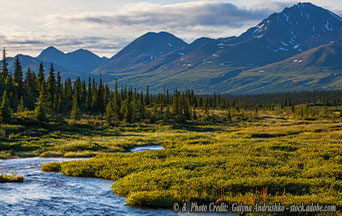The New Administration Does Not Think Alaska Should be a Natural History Museum
by Edwin Benson February 24, 2025 tfp/the-new-administration-does-not-think-
For many, environmentalists chief among them, Alaska has a peculiar “hands-off” quality. For them, it is more a natural history museum than one of the Union’s fifty co-equal states. Most of it is governed, as it were, by remote control. Two-thirds of its 365.4 million acres are managed in Washington, D.C. Those who administer it see the people who live there almost as an afterthought.
Domestic, Yet Somehow Foreign
On March 30, 1867, Secretary of State William Seward negotiated a $7.2 million price to purchase Alaska from Russia. The Senate ratified the treaty on May 30. The official transfer came on October 18. Some argued about the price; most howled with laughter. References to “Russia’s Frozen Asset,” “Seward’s Folly” and “Seward’s Polar Bear Garden” dominated newspaper coverage.
The derision quieted in 1896 when gold was discovered. After Pearl Harbor, the Army built the Alcan (Alaska-Canada) Highway to truck supplies to the region for the fight against Japan. During the Cold War, Americans breathed easier knowing there was a frigid buffer between the lower forty-eight states and the U.S.S.R. The Alaska Territory became the forty-ninth state on January 3, 1959.
Even now, Alaska’s status is unique. It is in the United States, but yet, not entirely of it. Americans cruise there each summer to experience the midnight sun.
In January 2025, the Alaskan “tug of war” entered a new phase.
The Biden Policy
Four years earlier, President Biden had signed Executive Order #13990. The priorities were evident in the first paragraph.
“Our Nation has an abiding commitment to empower our workers and communities; promote and protect our public health and the environment; and conserve our national treasures and monuments, places that secure our national memory. Where the Federal Government has failed to meet that commitment in the past, it must advance environmental justice.”
EO #13990 was only the beginning. At the close of Mr. Biden’s term, The Wall Street Journal summarized those executive actions in withering terms.
“Mr. Biden treated America’s largest state worse than he did Iran…. [H]e suspended and stymied Congressionally mandated lease sales in the Arctic National Wildlife Refuge, blocked oil and gas development in nearly half the National Petroleum Reserve, banned drilling in the northern Bering Sea, canceled lease sales in the Cook Inlet, slapped a roadless rule on millions of acres of forest, choked off mining projects, and denied Alaska Native veterans promised land allotments.”
Alaskans’ Discontent
The effects on Alaska’s economy have been catastrophic. The left-leaning Associated Press (AP) pointed out that “oil production…is a fraction of what it once was,…and for more than a decade, more people have left Alaska than have moved here.”
Over the four years of his administration, President Biden took—according to a list assembled by Alaska Senator Dan Sullivan’s office—”Seventy Executive Orders and Actions Targeting Alaska.” The Senator’s office refers to the cumulative effect as the “Last Frontier Lock-Up.”
President Trump’s priorities differ greatly from those of President Biden. Many of Mr. Trump’s economic policies hinge on increasing energy production and, in the process, lowering gasoline, heating oil, natural gas and coal prices to consumers.
A Liquid Gold Mine
In the new president’s inaugural address, he emphasized the importance of his policies.
“[W]e have something that no other manufacturing nation will ever have—the largest amount of oil and gas of any country on earth—and we are going to use it. We’ll use it. We will bring prices down, fill our strategic reserves up again right to the top, and export American energy all over the world. We will be a rich nation again, and it is that liquid gold under our feet that will help to do it.”
Alaska Governor Mike Dunleavy is delighted. Two weeks after Mr. Trump was elected, the governor sent the president-elect a twenty-seven-page document detailing his proposals. The attached cover letter conveyed Mr. Dunleavy’s sentiments.
“Your election will hail in a new era of optimism and opportunity, and Alaska stands ready to and is eager to work with you to repair this damage wrought by the previous administration and to set both Alaska and America on a course to prosperity.”
Wildly Varying Opinions
Senator Sullivan echoed the cadences of the Reagan Administration. “It is morning again in Alaska.”
Voice of America attempted to present a Native American Indian viewpoint. It found a surprising divergence. Aaron Payment, former chairperson of the Sault Ste. Marie Tribe of Chippewa in Northern Michigan, sees various bands pursuing their economic interests. “There are some tribes, I think energy [producing] tribes, that are probably going to be pleased with the outcome because they didn’t quite jump on board on the clean energy [agenda].”
Of course, the environmental lobby—used to calling the shots vis-à-vis Alaska—howled in dismay.
Shrieks of Horror
CNN characterized the pronouncement as “Trump’s under-the-radar Alaska order.” A gaggle of four New York Times writers fear global dictatorship. “[T]he declarations underscore how Mr. Trump views the world: oil and gas are symbols of strength and power, and plentiful fossil fuels will ensure that the United States is able to dominate allies and rivals alike.”
The lawyers at Earthjustice (which dubs itself as “the premier nonprofit public interest environmental law organization”) foresee limitless disaster. “The Trump administration’s agenda for Alaska would destroy valuable habitats and subsistence hunting and fishing grounds while furthering the climate crisis…. Trump once again forces a harmful industry-driven agenda on our state for political gain and the benefit of a wealthy few.”
Backcountry Hunters and Anglers apparently opposes any development of Alaska. Its Director of Policy and Government Relations told Field and Stream, “America’s Arctic is our largest expanse of intact public lands, and wilderness quality landscapes such as the coastal plain of the Arctic National Wildlife Refuge represent the most treasured of these…. [I]t is abundantly clear that further attempts to develop this crown jewel of the national wildlife refuge system should be abandoned, not doubled down on.”
Allowing God Into the Conversation
However, constructing a giant regulatory dome over Alaska to preserve every pebble serves no one’s best interests. This generation inherits a commission given by God, as stated in Genesis 1:28-30.
“And God blessed them, saying: Increase and multiply, and fill the earth, and subdue it, and rule over the fishes of the sea, and the fowls of the air, and all living creatures that move upon the earth. And God said: Behold I have given you every herb bearing seed upon the earth, and all trees that have in themselves seed of their own kind, to be your meat: And to all beasts of the earth, and to every fowl of the air, and to all that move upon the earth, and wherein there is life, that they may have to feed upon. And it was so done.”
God did not set aside large areas that were never to be occupied or used. Nor should mankind wantonly consume His gifts. God intended the earth’s resources to support humanity as the pinnacle of His creation. At the same time, this bounty is to be used wisely and passed down to future generations. That task involves wisdom, not adherence to the blind rantings of a self-selected few.

 3 godzin temu
3 godzin temu
















